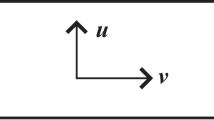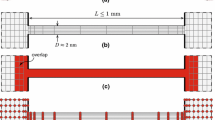Abstract
This article discusses the modeling of liquid flow inside nanotube membranes. Applying known simplifications to the classical fluid model leads to the so-called Hagen–Poiseuille equation, which predicts no flow for diameters up to 1 nm, and very modest flows in nanochannels up to 100 nm. The main feature of classical fluid dynamics that negates the possibility of high flow is the assumption that fluid molecules closest to the channel wall stick to it, the no-slip boundary condition. In the past 10 years, a wealth of experimental evidence has, on the contrary, demonstrated significant water flow in nanotubes with diameters equal to or smaller than 1 nm, opening the possibility of nanotube membranes capable of high flows and fine separation. These high flows have also been observed in molecular dynamics simulations, particularly for water flowing through carbon nanotubes, showing the presence of strong water slip near the walls of the nanotubes. The term “flow enhancement” has been introduced to refer to the ratio of predicted (or measured) flows and the no-slip Hagen–Poiseuille equation. Both experimental and modeling results point to a strong effect on flow enhancement of the interaction between the fluid and the tube’s wall, particularly the wall surface chemistry and structure.


Similar content being viewed by others
References
K.P. Lee, T.C. Arnot, D. Mattia, J. Membr. Sci. 370, 1 (2011).
S. Trivedi, K. Alameh, SpringerPlus 5, 1158 (2016).
B. Corry, Energy Environ. Sci. 4, 751 (2011).
D. Mattia, K.P. Lee, F. Calabrò, Curr. Opin. Chem. Eng. 4, 32 (2014).
J.K. Holt, H.G. Park, Y. Wang, M. Stadermann, A.B. Artyukhin, C.P. Grigoropoulos, A. Noy, O. Bakajin, Science 312, 1034 (2006).
M. Majumder, N. Chopra, R. Andrews, B.J. Hinds, Nature 438 (7064), 44 (2005).
M. Whitby, N. Quirke, Nat. Nanotechnol. 2, 87 (2007).
K. Ritos, D. Mattia, F. Calabrò, J.M. Reese, J. Chem. Phys. 140 (1), 014702 (2014).
D. Mattia, H. Leese, K.P. Lee, J. Membr. Sci. 475, 266 (2015).
D. Mattia, F. Calabrò, Microfluid. Nanofluid. 13, 125 (2012).
F. Calabrò, K.P. Lee, D. Mattia, Appl. Math. Lett. 26, 991 (2013).
M. Majumder, N. Chopra, B.J. Hinds, ACS Nano 5, 3867 (2011).
F. Du, L. Qu, Z. Xia, L. Feng, L. Dai, Langmuir 27, 8437 (2011).
C. Lee, S. Baik, Carbon 48 (8), 2192 (2010).
W. Mi, Y.S. Lin, Y. Li. J. Membr. Sci. 304 (1–2), 1 (2007).
Y. Baek, C. Kim, D.K. Seo, T. Kim, J.S. Lee, Y.H. Kim, K.H. Ahn, S.S. Bae, S.C. Lee, J. Lim, K. Lee, J. Yoon, J. Membr. Sci. 460, 171 (2014).
M. Yu, H.H. Funke, J.L. Falconer, R.D. Noble, Nano Lett. 9, 225 (2008).
E. Ruckenstein, P. Rajora, J. Colloid Interface Sci. 96 (2), 488 (1983).
T.D. Blake, Colloids Surf. 47, 135 (1990).
T. Sisan, S. Lichter, Microfluid. Nanofluid. 11, 787 (2011).
J.H. Walther, K. Ritos, E.R. Cruz-Chu, C.M. Megaridis, P. Koumoutsakos, Nano Lett. 13, 1910 (2013).
B. Corry, J. Phys. Chem. B 112 (5), 1427 (2008).
S.K. Kannam, B.D. Todd, J.S. Hansen, P.J. Daivis, J. Chem. Phys. 138, 94701 (2013).
T. Werder, J.H. Walther, R.L. Jaffe, T. Halicioglu, P. Koumoutsakos, J. Phys. Chem. B 107 (6), 1345 (2003).
D. Mattia, Y. Gogotsi, Microfluid. Nanofluid. 5, 289 (2008).
M.H. Köhler, L. Barros da Silva, Chem. Phys. Lett. 645, 38 (2016).
J.A. Thomas, A.J.H. McGaughey, Phys. Rev. Lett. 102, 184502 (2009).
D.C. Tretheway, C.D. Meinhart, Phys. Fluids 14, L9 (2002).
C.H. Choi, J.A. Westin, K.S. Breuer, Phys. Fluids 15, 2897 (2003).
K. Watanabe, Y. Udagawa, H. Udagawa, J. Fluid Mech. 381, 225 (1999).
K.P. Lee, H. Leese, D. Mattia, Nanoscale 4 (8), 2621 (2012).
S. Joseph, N.R. Aluru, Nano Lett. 8, 452 (2008).
W.D. Nicholls, M.K. Borg, D.A. Lockerby, J.M. Reese, Mol. Simul. 38 (10), 781 (2012).
M. Majumder, B. Corry, Chem. Commun. 47, 7683 (2011).
D. Mattia, H.H. Bau, Y. Gogotsi, Langmuir 22, 1789 (2006).
D. Mattia, M.P. Rossi, B.M. Kim, G. Korneva, H.H. Bau, Y. Gogotsi, J. Phys. Chem. B 110, 9850 (2006).
D. Mattia, H. Leese, F. Calabrò, Philos. Trans. R. Soc. Lond. A 374 (2060), 20150268 (2016).
W.D. Nicholls, M.K. Borg, D.A. Lockerby, J.M. Reese, Microfluid. Nanofluid. 12, 257 (2012).
S. Sisavath, X. Jing, C.C. Pain, R.W. Zimmerman, J. Fluids Eng. 124 (1) 273 (2002).
W.-F. Chan, H.-Y. Chen, A. Surapathi, M.G. Taylor, X. Shao, E. Marand J.K. Johnson, ACS Nano 7, 5308 (2013).
J.N. Shen, C.C. Yu, H.M. Ruan, C.J. Gao, B. Van der Bruggen, J. Membr. Sci. 442, 18 (2013).
H. Wu, B. Tang, P. Wu, J. Membr. Sci. 428, 425 (2013).
J.-H. Choi, J. Jegal, W.-N. Kim, J. Membr. Sci. 284, 406 (2006).
M. Bedewy, E.R. Meshot, H. Guo, E.A. Verploegen, W. Lu, A.J. Hart, J. Phys. Chem. C 113 (48), 20576 (2009).
M. Menon, E. Richter, A. Mavrandonakis, G. Froudakis, A. Andriotis, Phys. Rev. B Condens. Matter 69, 1 (2004).
K. Malek, M. Sahimi, J. Chem. Phys. 132, 014310 (2010).
Acknowledgments
The author gratefully acknowledges support from The Engineering and Physical Sciences Research Council Thought Project EP/ M01486X/1 “From Membrane Material Synthesis to Fabrication and Function (SynFabFun).”
Author information
Authors and Affiliations
Corresponding author
Rights and permissions
About this article
Cite this article
Calabrò, F. Modeling the effects of material chemistry on water flow enhancement in nanotube membranes. MRS Bulletin 42, 289–293 (2017). https://doi.org/10.1557/mrs.2017.58
Published:
Issue Date:
DOI: https://doi.org/10.1557/mrs.2017.58




